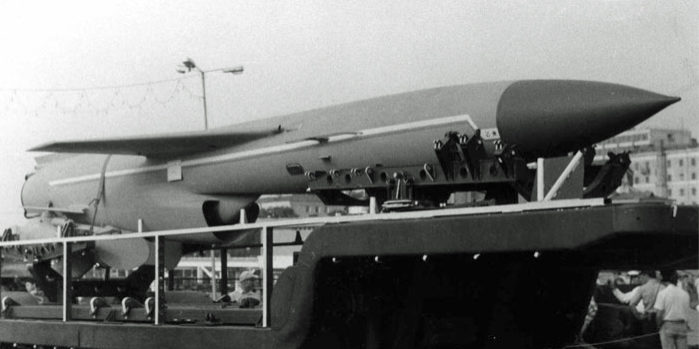Quick Facts
| Russian/US Designation | P-6 Progress/SS-N-3C Shaddock |
| Role and Mobility | Cruise Missile and Coastal Area Defense; Submarine-Mobile |
| Designer/Production | NPO Mashinostroyenya Chelomey |
| Range | 450 km |
| Warhead Type and Weight | Conventional/Nuclear; 1000 kg |
| MIRV and Yield | Unknown; 100 kt |
| Guidance System/Accuracy | Terminal Active Radar Homing; Unknown |
| Stages/Propellant | Two; Solid |
| IOC/Retirement | 1959; 1990 |
| Status/Number of Units | Retired; N/A |
Overview
In the early 1950s, it became clear that the US aircraft-carrier battlegroup represented the most significant threat to the offensive and defensive Soviet naval operations.[i] In defense, the Soviet Union developed the P-6 Progress or the SS-N-3 Shaddock that could defend the coastal regions of the Soviet Union and any land operations. The Progress is a submarine-based, supersonic, anti-ship cruise missile.[ii] It can travel up to Mach 1.5 and has a maximum range of 450 km.[iii] There are three known variants of this missile, all designated SS-N-3 by NATO.
Variants
P-6 Progress: Original Submarine-Based Anti-Ship Missile with radar homing
P-5 Pyatyorka: Submarine-Based Variant with inertial guidance
P-35 Progress: Ship-Based Variant
All variants have since been retired and replaced by the P-500 Bazalt and P-700 Granit.[iv]
Strategic Implications
At the time of its deployment, the P-6 Progress was strategically valuable because it gave the Soviet Navy a long-range anti-ship capability for the first time.[v] The drawback of the Progress was that it originally required submarines remained surfaced for 30 or more minutes until the missile’s seekers lit up, creating a major vulnerability. Its heavy reliance on datalinks also provided opportunities for jamming.[vi] In order to combat these issues, the Soviet Union developed of an airborne surveillance and acquisition system to improve targeting and allow the submarines firing the weapons to re-submerge faster.[vii] Aspects of this new guidance system are still used in Russia today.
Recent News
References
[i] https://web.archive.org/web/20120205005744/http://www.dtig.org/docs/Russian-Soviet%20Naval%20Missiles.pdf
[ii] https://fas.org/nuke/guide/russia/theater/ss-n-3.htm
[iii] https://web.archive.org/web/20120205005744/http://www.dtig.org/docs/Russian-Soviet%20Naval%20Missiles.pdf
[iv]https://web.archive.org/web/20120712145840/http://quocphong.baodatviet.vn/Home/QPCN/Sat-thu-tau-san-bay-mot-thoi/20118/161042.datviet
[v] https://web.archive.org/web/20120205005744/http://www.dtig.org/docs/Russian-Soviet%20Naval%20Missiles.pdf
[vi] http://www.ausairpower.net/APA-Rus-Cruise-Missiles.html#mozTocId742062
[vii] Ibid.

